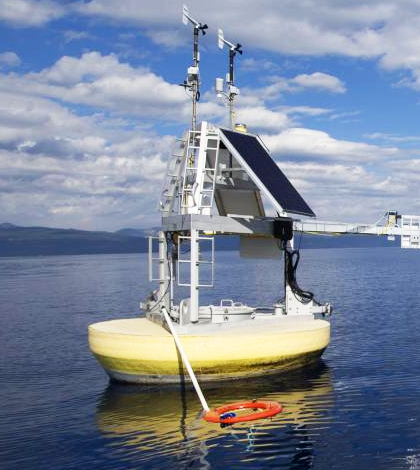Lake Tahoe’s Signature Blueness Comes From Algae, Not Clarity

The research buoy houses a hyperspectral instrument that stares down into the lake and measures light distribution and wavelength in very fine increments. (Credit: UC Davis)
If anyone knows the captivating power of Lake Tahoe firsthand, it’s Geoffrey Schladow.
For the past 11 years, he’s led scientific work around the renowned lake as director of the University of California, Davis, Tahoe Environmental Research Center — but more than a decade of study hasn’t diminished his sense of the lake’s most compelling property.
“I think when people come to Tahoe and they drive over the pass and suddenly have their first view of the lake, what they see is its blueness,” he said.
Whether viewed in person or through a photograph, Lake Tahoe’s deep cerulean hue can seem otherworldly. Perhaps it’s fitting, then, that determining the mechanism behind that striking color took some help from an agency with plenty of experience working beyond this world.
A study led by UC Davis postdoctoral researcher Shohei Watanabe used data from a NASA Jet Propulsion Laboratory buoy to develop a blueness index for the lake and examine the roots of its color. The results of the study are published online in the TERC’s State of the Lake Report 2015.
“The State of the Lake Report is something we’ve been doing for nine years,” said Schladow, who’s also a professor of water resources and environmental engineering at UC Davis. “It’s a report on the almost half-century of ongoing monitoring and data collection that we do.”
This year’s report found that Lake Tahoe’s blueness is determined by algal concentrations in the lake, and that the lake is least blue when it exhibits the highest clarity — a finding that shatters preconceived notions about the relationship between both variables.

The research buoy houses a hyperspectral instrument that stares down into the lake and measures light distribution and wavelength in very fine increments. (Credit: UC Davis)
“That really caught us by surprise,” Schladow said. “The assumption that we had made — and just about everybody else — is that clarity and blueness were literally one in the same; that they covaried.”
The NASA research buoy that provided the data was designed to verify satellite observations over the lake. The buoy houses a specialized hyperspectral instrument that stares down into the lake and measures light distribution and wavelength in very fine increments. From these measurements, researchers can pinpoint the precise color of the water.
Using the blueness index, Schladow said the TERC is keeping an eye on Lake Tahoe’s color and how it changes across spans of time from throughout the day to throughout the year. Understanding the mechanism behind the lake’s blueness should help researchers and managers better address its issues related to clarity (Under the Clean Water Act, Lake Tahoe is considered an impaired lake in regards to its clarity).
“We have to do two things,” Schladow said. “We have to control particles to improve clarity, but we also have to reduce nutrients in order to get the blueness to the level that we want.” Nutrients are the primary factor determining algal concentrations in the lake, Schladow said.

UC Davis researcher Shohei Wantanabe gathers data from a NASA Jet Propulsion Lab research buoy. (Credit: UC Davis)
Unlike in most watersheds, the Tahoe Basin doesn’t feature agriculture, mining or forestry operations, so traditional nutrient inputs aren’t much of a problem. In fact, it’s the tourists drawn to Lake Tahoe’s beauty that are likely the main source of nutrient deposition in the lake. In the summer, tourists and their motor vehicles swarm Tahoe for camping, hiking and water recreation, while skiing is a major draw in the winter.
“One of the largest sources of nutrients — especially nitrogen — in the Tahoe Basin is atmospheric deposition,” Schladow said. “There’s always been a big concern here about trying to reduce atmospheric loading.” The basin’s natural morphology tends to trap particulate matter — including nitrogen-rich car exhaust — suspended above the lake, Schladow explained.
“This study will be hopefully further impetus, or at least further reason, to continue with (nutrient reduction) efforts, to try to get people out of their cars and driving less in the basin,” Schladow said.
A variety of local, state and federal agencies are considering management options such as wetland construction to reduce nutrient loads in Lake Tahoe and improve its overall ecological health.
“That’s a difficult thing to measure with one or two parameters,” Schladow said. “But clarity and blueness are certainly good indicators and they tell us when things are changing for the better and changing for the worse.”
Top image: The research buoy houses a hyperspectral instrument that stares down into the lake and measures light distribution and wavelength in very fine increments. (Credit: UC Davis)




0 comments